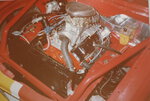I will oblige to respond although I have my own opinions on all of this. The confusion you are experiencing is unfortunate because its kind of unavoidable at this point.
When they say 'external pcv' what they mean is they are moving the cyclonic oil separators to the outside as you know. To do this, all that voodoo under the valvecover gets bypassed which is why aftermarket vc's don't need to have it. Its also the reason that plugging head ports is mandatory when you run an after market VC, because there is no PCV valve on that pathway to block boost from entering the crank case.
So as a very short review, in a normal situation when you're idling, the minimal blowby existing in the crank case is being sucked out by going past the pcv valve, and into the individual head port channels, into the head etc. This is the 'low side' operation. During boost, that process attempts to reverse, it goes up the individual head port channels, but the pcv valve blocks it from going any further so you don't pressurize the crank case with your intake charge.
When this gets 'externalized' what happens is instead of crank case blow by being sucked through the pcv valve toward those head port channels, the external PCV valve redirects that flow out a barb on the back of the VC. That goes to your low side can, and then from there it goes to the Throttle body back into the manifold, back into the engine. So instead of going through the head ports, it takes a long way around essentially and that is the externalization.
So when you run an aftermarket VC, it is assumed you are doing this already. By that I mean, plugging the head ports and sucking crank case blowby from one of those VC ports, into the tb etc. There is no magic inside the VC that requires there to be any sort of separation or compartments etc. The high/low side concept is nothing more than a "how does crank case ventilate from the VC" question. Does it get sucked into the engine via the throttle body through one port or does it get pushed out of another.
Do not confuse VTA with PCV delete. You Venting To Atmosphere just means the crank case fumes are being expelled to the open air and not being re-ingested somewhere, except maybe your lungs. People tend to throw these terms around as they usually are done together but it isn't so. You can VTA the high side on a PCV setup, in fact I think most single turbo people do as there isn't a good place to recirculate it.
I can't see for sure, but if I were to guess, he's got a dual can setup from VTT. The hose on the VC closer to the firewall goes to one can and then outlets downward with a one way check valve going to the throttlebody or a port on the intake manifold. This is his 'low side'. He also has a vacuum break on the front of the VC, this acts as his flapper so he doesn't over-vacuum the crank case and cause the seal howling issue.
The other port off the vc runs to the other catch can and is VTA off that filter there. So this is a good example of a 'PCV setup' which is also VTA.
If you have a dual can setup now with external PCV, the only thing changing is the fittings going to the valve cover and ensuring your head ports are plugged. So instead of the External PCV valve, the one with the nipple, you'd be replacing that with a normal 10AN fitting with a barb on it or whatever your hoses need. And if you've got a flapper valve hooked up to your other can, you'd have to make some fittings to convert 10AN to some 3/4 barb so you can put a hose over the flapper and then from the flapper run to your other catch can and then back into the inlet or VTA.
If you don't want to do hose conversion on the flapper, you can just run the 10AN from the VC directly to the catch can and VTA/Inlet and then you'll need to install the vacuum break on a third port of the VC.






